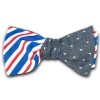Adjustable Bow Ties
One of the early things that I realised when making bow ties was that people’s necks are different sizes. Totally different sizes. This obviously has an implication on tie production, and may be one reason why the traditional necktie is more popular that the bow tie. The traditional necktie is a one-size-fits-all design. It’s inherently adjustable—unlike most other items of clothing—you decide how to ‘size’ it as you tie it.
The bow tie is less so. It’s not totally unadjustable, though it can be made to be. In general though, compared to the traditional necktie, it’s a little harder to instil a one-size-fits-all design without additional engineering and material usage. At first, when starting out with Bowtiful, I opted for the easy way out and made ties a fixed length in what I deemed were the most popular neck sizes – 15, 15.5 and 16 inches. This obviously had its implications, but some were more far reaching than I initially thought. A selection of them include:-
- A portion of the market is immediately being excluded by not making ties in all sizes.
- The amount of stock required, and the numbers of ties in each size is a total unknown.
- Minute adjustments once a bow tie is tied are generally impossible with a fixed length tie. You lose the opportunity to tighten the tie by pulling the neck strap on either side of the bow. This generally makes the ties (when tied) not have as much immediate potential to look AWESOME.
- The potential to tie a tie off your neck and then fasten it on to your neck once (perfectly) tied is lost.
- People like to wear their bows in different sizes. With a fixed length and a fixed neck size (this is assuming people aren’t able to change their neck size on demand) there’s little room for bow size variation
- The manufacture is a whole lot harder when you have to worry about custom sizing.
The traditional method of allowing adjustability in a bow tie is with a little hook and eye sort of mechanism. One end of the tie has a hook which can be inserted into a number of different holes/eyes on the other half of the tie to allow for different neck sizes. It’s not elegant, but it works. It’s also pretty fiddly, and actually lacks a whole bunch of adjustability if you want to change the neck size slightly once you’ve tied the tie. It’s not really ideal, but it’s the accepted norm in the bow tie industry, and 99% of manufacturers use it.
Here at Bowtiful we hate to follow norms and ideals. Challenging the preconception is where the fun is at, so we figured we would do the adjustable bow tie a little differently (and frankly far better). To do this, we borrowed a nifty fastening mechanism from the bow tie’s friend in the ‘mens accessory’ family, the belt. In particular, the summery canvas belts that use 2 D-rings for fastening. Frankly I was a little surprised that no-one else was using such a fastening method when I first thought about the idea. It’s so simple, requires easily available, sturdy and cheap raw materials, and it actually works.
Bowtiful ties are made in two halves, both of roughly equal length. One half has two D-rings attached to it, and the other half is threaded through, allowing ultimate and previously unforeseen levels of adjustability. Here’s a photo example of what it looks like. From our friend Uncle Sam:
And another great thing about it, it works with all tie materials (so far that I’ve tested). Cotton tends to be a fairly rough material (at least compared to silk) so it was bound to work with that, but it works equally well with silk (despite the reservations that tie aficionado Thomas Fink had). All Bowtiful ties now use this method to provide awesome adjustability. They fit all neck sizes from sticky to stocky. Try one out today!





